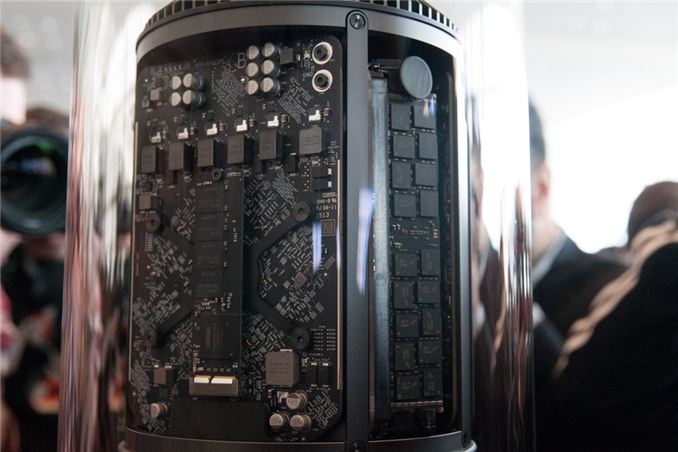Up Close with the New Mac Pro
by Anand Lal Shimpi on June 10, 2013 3:15 PM EST
In its keynote this morning, Apple teased its next-generation Mac Pro, due out later this year. Based on Ivy Bridge E, the new system will ship with two AMD FirePro GPUs with up to 4096 SPs and capable of delivering 7 TFLOPS of peak FP performance.
We got a close look at the chassis, which is 1/8 the size of the current Mac Pro. You lose any hope for internal expansion, but Apple outfitted the machine with three Falcon Ridge Thunderbolt 2 controllers to enable expansion via external storage and external Thunderbolt 2 expansion chassis options. Apple won't make any of its own Thunderbolt 2 expansion chassis, but you can expect that others will fill that void. With 20Gbps up/down on Thunderbolt 2, you should have enough bandwidth for any PCIe expansion.
Internally there are four DDR3 memory slots, as well as what looks like a proprietary PCIe SSD connector (I don't think it's M.2 unfortunately). Both GPUs are technically removable, but at least one is mounted as the same card as the PCIe SSD. Apple is putting every single PCIe lane available to use on the new Mac Pro.
















137 Comments
View All Comments
BrazenRain - Monday, June 10, 2013 - link
Stick a whisk, a plunger, and a periscope on it and you have Apple's real plans to wipe out the competition.MTS - Monday, June 10, 2013 - link
Where is the power supply? Is it some big fugly walwart?MTS - Monday, June 10, 2013 - link
's pretty impressive.MTS - Monday, June 10, 2013 - link
Nevermind. I see the A/C input. That's pretty impressive.cheinonen - Monday, June 10, 2013 - link
There's a standard IEC power port on the back, below the HDMI port.MTS - Monday, June 10, 2013 - link
This looks like something you could get sent to you from the drive thru at the bank. You send in $3500, the bank shoots out a Mac Pro via their tube.frogger4 - Monday, June 10, 2013 - link
Man. The thermal profile just scares me. That's at least 100W of CPU and likely 400W of GPU heat that has to be removed. It looks fresh air is sucked in the top and exhausted out the bottom - I suppose the whole center of the chassis is heatsink. At any rate, I like the design but it will be either loud or toasty hot.slippysoup - Monday, June 10, 2013 - link
Apple's site has some good pictures of the "thermal core". Basically the whole center of the tube is a triangular heat sink with a GPU or CPU on each face. The fan on top draws air from the bottom, through the heat sink and out the top. I'm not much of an Apple fan but I have to admit that the cooling design is really elegant. We'll see how it works in practice though.JDG1980 - Tuesday, June 11, 2013 - link
Probably the closest thing in the DIY PC market is the SilverStone FT02, with its stack-effect cooling design enabled by rotating the motherboard 90 degrees. Tests show it does extremely well on thermals, at least if you select appropriate heatsinks and orient them properly (so the intake air goes through the fins rather than being blocked by them). I suspect you could get away with just using the intake fans on a reasonably good CPU and GPU if you had coolers with wide-spaced fins like the HR-02 Macho and Accelero S1 Plus. In fact, I'm going to try something like this for my next build.Spoony - Tuesday, June 11, 2013 - link
In the top and out the bottom would be horrible. The G4 Cube was convection cooled, that is to say it used the natural movement of hot air upwards to suck cool air in the bottom and create an effective fanless cooler.This is another take on that concept. Cool air is sucked in the bottom, through the fins in the thermal core. They have a puller turbine which blows the hot air out the top. The natural convection combined with turbine assist tends to make this sort of design very efficient and quiet.
With the machine idle you can probably stop the fan entirely. Fan speed required to expel 500-600W of heat wouldn't be higher than 1500rpm or so (educated guess), and probably even slower. It is a neat design, but as we can all see a tremendous number of custom parts are required to make it work.